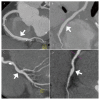Prevalence of coronary artery ectasia in older adults and the relationship with epicardial fat volume by cardiac computed tomography angiography
- PMID: 23610568
- PMCID: PMC3627703
- DOI: 10.3969/j.issn.1671-5411.2013.01.003
Prevalence of coronary artery ectasia in older adults and the relationship with epicardial fat volume by cardiac computed tomography angiography
Abstract
Objective: Coronary artery ectasia (CAE) refers to abnormal dilation of coronary artery segments to 1.5 times of adjacent normal ones. Epicardial fat is associated with cardiovascular risk factors. The relationship between CAE and epicardial fat has not yet been investigated. This study aimed to assess the relationship between CAE and epicardial fat volume (EFV) in older people by dual-source computed tomography coronary angiography (CTCA).
Methods: We prospectively enrolled 1400 older adults who were scheduled for dual-source CTCA. Under reconstruction protocols, patients with abnormal segments 1.5 times larger than the adjacent segments were accepted as CAE. EFV was measured by semi-automated software. Traditional risk factors in CAE patients, as well as the extent of EFV, were analyzed and compared to non-CAE group.
Results: A total of 885 male and 515 female older patients were enrolled. CAE was identified by univariable analysis in 131 patients and significantly correlated to hypertension, smoking, hyperlipidemia, prior percutaneous coronary intervention and ascending aorta aneurysm. EFV was shown to be significantly higher in CAE patients than patients without ectasia. In multivariable analyses, EFV (P = 0.018), hypertension (P < 0.001) and hyperlipidemia (P < 0.001) were significantly correlated to CAE. There was a significant negative correlation between EFV and Markis classification.
Conclusions: CAE can be reliably recognized by dual-source CTCA. Epicardial fat might play a role in etiopathogenesis and progression of CAE, providing a new target for treating ectasia.
Keywords: Cardiac computed tomography angiography; Coronary artery ectasia; Epicardial fat.
Figures


Similar articles
-
Coronary artery ectasia diagnosed using multidetector computed tomography: morphology and relation to coronary artery calcification.Int J Cardiovasc Imaging. 2013 Feb;29(2):427-33. doi: 10.1007/s10554-012-0079-4. Epub 2012 Jun 21. Int J Cardiovasc Imaging. 2013. PMID: 22718361
-
Association of Epicardial Fat Volume with Coronary Artery Ectasia and Coronary Artery Disease.Angiology. 2023 Jul;74(6):563-568. doi: 10.1177/00033197221124776. Epub 2022 Aug 30. Angiology. 2023. PMID: 36039654
-
Prevalence and morphology of coronary artery ectasia with dual-source CT coronary angiography.Eur Radiol. 2008 Dec;18(12):2776-84. doi: 10.1007/s00330-008-1087-6. Epub 2008 Jul 19. Eur Radiol. 2008. PMID: 18641995
-
Treatment and Outcome of Patients With Coronary Artery Ectasia: Current Evidence and Novel Opportunities for an Old Dilemma.Front Cardiovasc Med. 2022 Feb 4;8:805727. doi: 10.3389/fcvm.2021.805727. eCollection 2021. Front Cardiovasc Med. 2022. PMID: 35187112 Free PMC article. Review.
-
Ratio of Serum Aspartate to Alanine Aminotransferase as a Marker of Isolated Coronary Artery Ectasia and its Severity.Heart Int. 2020 Jul 31;14(1):43-48. doi: 10.17925/HI.2020.14.1.43. eCollection 2020. Heart Int. 2020. PMID: 36277666 Free PMC article. Review.
Cited by
-
Clinical indicators and coronary angiographic features of expansive arterial remodelling in patients with abdominal aortic aneurysms.PLoS One. 2019 Jul 16;14(7):e0219730. doi: 10.1371/journal.pone.0219730. eCollection 2019. PLoS One. 2019. PMID: 31310617 Free PMC article.
-
Prevalence of Coronary Artery Ectasia with Atherosclerosis and Associated Risk Factors in the West of Iran: A Cross-Sectional Study.J Res Health Sci. 2016 Winter;16(1):22-5. J Res Health Sci. 2016. PMID: 27061992 Free PMC article.
-
Epidemiology and risk factors of coronary artery aneurysm in Taiwan: a population based case control study.BMJ Open. 2017 Jun 30;7(6):e014424. doi: 10.1136/bmjopen-2016-014424. BMJ Open. 2017. PMID: 28667203 Free PMC article.
-
Hypertension and coronary artery ectasia: a systematic review and meta-analysis study.Clin Hypertens. 2021 Jul 15;27(1):14. doi: 10.1186/s40885-021-00170-6. Clin Hypertens. 2021. PMID: 34261539 Free PMC article.
-
Common causes of geriatric medical emergencies in China.J Geriatr Cardiol. 2015 Jan;12(1):91-2. doi: 10.11909/j.issn.1671-5411.2015.01.012. J Geriatr Cardiol. 2015. PMID: 25678910 Free PMC article. No abstract available.
References
-
- Manginas A, Cokkinos DV. Coronary artery ectasias: imaging, functional assessment and clinical implications. Eur Heart J. 2006;27:1026–1031. - PubMed
-
- Boles U, Eriksson P, Zhao Y, et al. Coronary artery ectasia: remains a clinical dilemma. Coron Artery Dis. 2010;21:318–320. - PubMed
-
- Sultana R, Sultana N, Ishaq M, et al. The prevalence and clinical profile of angiographic coronary ectasia. J Pak Med Assoc. 2011;61:372–375. - PubMed
-
- Diaz-Zamudio M, Bacilio-Perez U, Herrera-Zarza MC, et al. Coronary artery aneurysms and ectasia: role of coronary CT angiography. Radiographics. 2009;29:1939–1954. - PubMed
-
- Dagli N, Ozturk U, Karaca I, et al. Adiponectin levels in coronary artery ectasia. Heart Vessels. 2009;24:84–89. - PubMed
LinkOut - more resources
Full Text Sources
